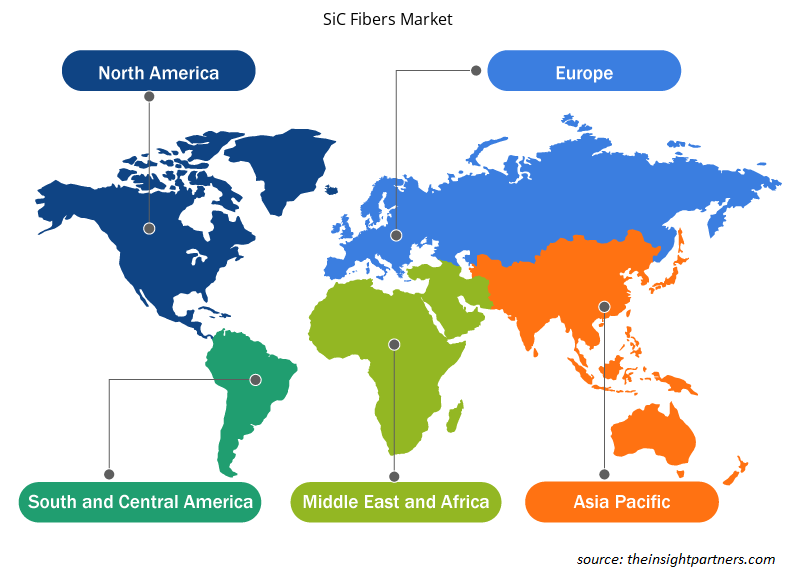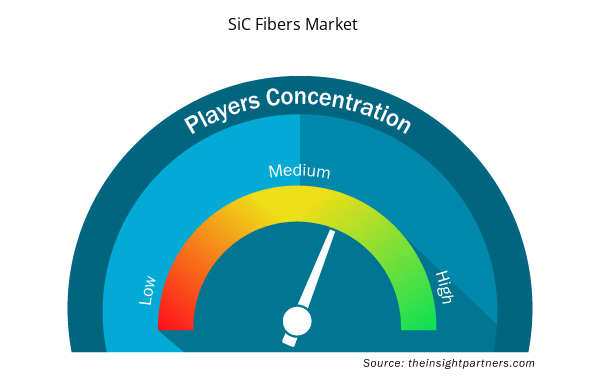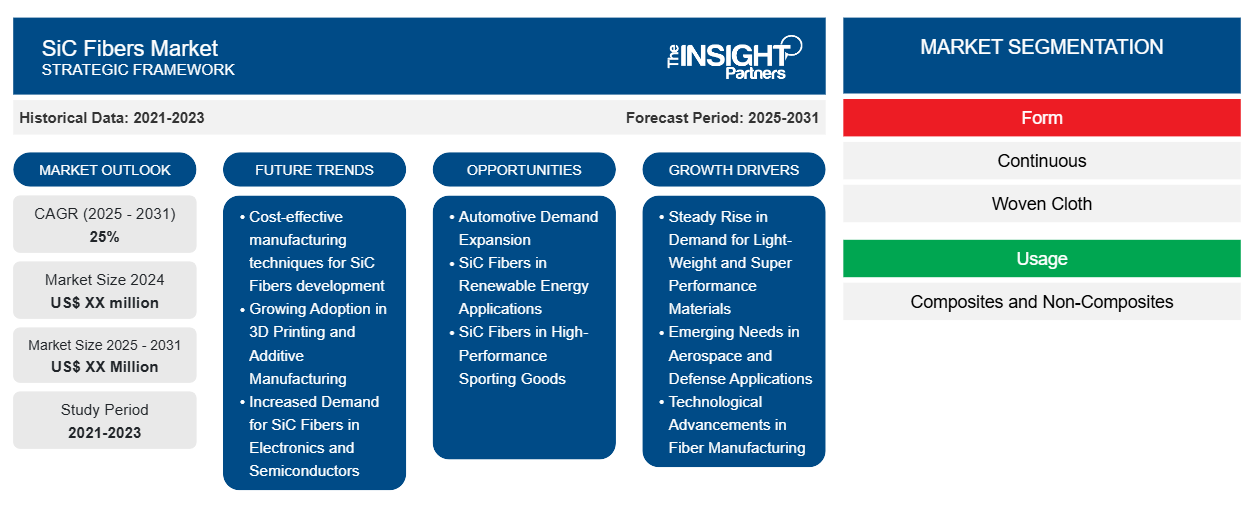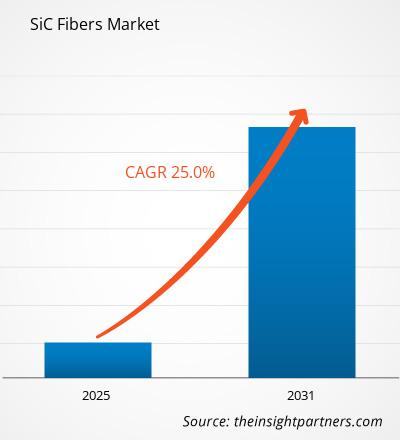Si prevede che il mercato delle fibre SiC registrerà un CAGR del 25% dal 2024 al 2031, con una dimensione di mercato in espansione da XX milioni di dollari USA nel 2024 a XX milioni di dollari USA entro il 2031.
Il mercato delle fibre SiC comprende l'analisi per forma (continua, tessuto e altri), utilizzo (compositi e non compositi) e settore di utilizzo finale (aerospaziale e difesa, energia e potenza, industriale e altri) e geografia (Nord America, Europa, Asia Pacifico, Medio Oriente e Africa e Sud e Centro America). Le fibre SiC sono composte principalmente da molecole di carburo di silicio, generalmente con un diametro compreso tra 5 ?m e 50 ?m. Capacità di alte temperature, minore espansione termica, minore densità, maggiore durata ossidativa, minore permeabilità, peso ridotto, maggiore resistenza e migliore conduttività termica sono le proprietà chiave delle fibre SiC che contribuiscono alla loro popolarità nei settori aerospaziale e difesa, energia e potenza e industriale.
Scopo del rapporto
Il report SiC Fibers Market di The Insight Partners mira a descrivere il panorama attuale e la crescita futura, i principali fattori trainanti, le sfide e le opportunità. Ciò fornirà spunti a vari stakeholder aziendali, come:
- Fornitori/produttori di tecnologia: per comprendere le dinamiche di mercato in evoluzione e conoscere le potenziali opportunità di crescita, consentendo loro di prendere decisioni strategiche informate.
- Investitori: condurre un'analisi completa delle tendenze in merito al tasso di crescita del mercato, alle proiezioni finanziarie del mercato e alle opportunità esistenti lungo la catena del valore.
- Enti di regolamentazione: regolamentano le politiche e le attività di controllo sul mercato allo scopo di ridurre al minimo gli abusi, preservare la fiducia degli investitori e sostenere l'integrità e la stabilità del mercato.
Segmentazione del mercato delle fibre SiC
Modulo
- Continuo
- Tessuto Tessuto
Utilizzo
- Compositi e non compositi
Settore di utilizzo finale
- Aerospaziale e difesa
- Energia e potenza
- Industriale
Geografia
- America del Nord
- Europa
- Asia-Pacifico
- America del Sud e Centro
- Medio Oriente e Africa
Personalizza questo report in base alle tue esigenze
Riceverai la personalizzazione gratuita di qualsiasi report, comprese parti di questo report, o analisi a livello nazionale, pacchetto dati Excel, oltre a usufruire di grandi offerte e sconti per start-up e università
- Scopri le principali tendenze di mercato in questo rapporto.Questo campione GRATUITO includerà analisi di dati che spaziano dalle tendenze di mercato alle stime e alle previsioni.
Fattori trainanti della crescita del mercato delle fibre SiC
- Aumento costante della domanda di materiali leggeri e ad alte prestazioni: le fibre di carburo di silicio (SiC) si distinguono per le loro proprietà meccaniche, vale a dire resistenza alla trazione, stabilità termica e bassa densità. Pertanto, sono adatte per applicazioni aerospaziali, automobilistiche e di difesa. La crescente domanda di materiali leggeri e ad alte prestazioni nei settori sopra menzionati, in particolare per applicazioni ad alta temperatura, ha portato le fibre di SiC a emergere rapidamente come uno dei componenti materiali importanti nei compositi avanzati.SiC) are distinct in their mechanical properties, namely, tensile strength, thermal stability, and low density. Therefore, they are suitable for aerospace, automotive, and defense applications. Increasing demand for lightweight and high-performance materials in the above sectors, especially for high-temperature applications, has led to SiC fibers fast emerging as one of the important material components in advanced composites.
- Nuove esigenze nelle applicazioni aerospaziali e di difesa: queste fibre SiC soddisferebbero efficacemente le specifiche dei componenti di peso ridotto ma elevata resistenza per applicazioni che includono parti per motori e pale di turbine nei settori aerospaziale e di difesa. L'attuale attenzione al miglioramento dell'efficienza del carburante con contemporanea perdita di peso nell'applicazione dell'aereo continua ad aumentare la sua dipendenza dalle industrie che richiedono fibre SiC per applicazioni ad alta temperatura e ad alto stress e quindi il mercato.
- Progressi tecnologici nella produzione di fibre: in tale gamma di cambiamenti rientra lo sviluppo di mezzi più efficaci e meno costosi per produrre fibre SiC. Pertanto, il materiale diventa più facilmente disponibile. Ciò significa che con la nuova tecnologia e i costi di produzione più bassi, la fibra SiC potrebbe presto rivelarsi commercialmente valida per molte delle sue potenziali applicazioni, il che porterà a una maggiore crescita per il mercato e a nuove opportunità in una varietà di aree.
Tendenze future del mercato delle fibre SiC
- Tecniche di produzione convenienti per lo sviluppo di fibre SiC: si prevede che la domanda di fibre SiC crescerà, guidando i miglioramenti nel processo di produzione verso prodotti di alta qualità a costi bassi. Ciò comporterà ottimizzazioni basate sui risparmi sui costi per tecniche come l'infiltrazione chimica da vapore (CVI) e la deposizione chimica da vapore laser (LCVD), abbassando così il prezzo dei prodotti in fibra SiC per ampie applicazioni commerciali che vanno dall'automotive all'energia e all'aerospaziale.
- Crescente adozione nella stampa 3D e nella produzione additiva: le fibre SiC saranno presto sempre più utilizzate nel settore della stampa 3D: in particolare per parti ad alte prestazioni. Più la tecnologia si sviluppa nel caso della produzione additiva, più le fibre SiC saranno richieste nella costruzione di strutture complesse, leggere e altamente durevoli, tanto che saranno maggiormente utilizzate nelle operazioni aerospaziali, automobilistiche e nelle applicazioni di difesa, perché in questo caso la tolleranza e la resistenza dei materiali sono più esigenti.
- Aumento della domanda di fibre SiC nell'elettronica e nei semiconduttori: la rivoluzione del carburo di silicio nell'elettronica, in particolare nei semiconduttori, sta aprendo nuove frontiere per le fibre SiC. Tali fibre hanno eccellenti proprietà di conduzione termica e resistenza all'alta tensione e sono quindi le più adatte per applicazioni nell'elettronica avanzata, nei sistemi di alimentazione e nelle reti. Inoltre, l'introduzione di dispositivi elettronici di nuova generazione fungerà da motore di crescita in questo spazio.
Opportunità di mercato delle fibre SiC
- Espansione della domanda automobilistica: poiché l'industria automobilistica si sta muovendo rapidamente verso il futuro dei veicoli elettrici (EV) e della riduzione delle emissioni di CO2, il SiC ha un grande potenziale. Il potenziale utilizzo delle fibre SiC nei componenti dei motori elettrici, nelle batterie e nei sistemi di gestione termica può essere molto interessante e utile per migliorare le prestazioni e l'efficienza del veicolo elettrico. Le fibre SiC vengono esplorate dai produttori per quanto riguarda le elevate prestazioni e l'efficienza energetica dei veicoli, ricercate dal mercato in crescita.
- Fibre SiC nelle applicazioni di energia rinnovabile: la formazione di componenti più efficienti e duraturi per turbine e sistemi di alimentazione avrà effetto grazie alle fibre SiC in linea con le crescenti tecnologie di energia rinnovabile come solare ed eolica. Con la loro elevata conduttività termica, resistenza all'usura ed eccellente resistenza in situazioni estreme, le fibre SiC sono ideali per migliorare le prestazioni nelle applicazioni di energia rinnovabile.
- Fibre SiC in articoli sportivi ad alte prestazioni: l'introduzione di queste fibre nella produzione di attrezzature utilizzate negli sport ad alte prestazioni, come biciclette sportive, caschi e dispositivi di protezione, è una delle applicazioni emergenti. La loro leggerezza, resistenza e resistenza agli urti potrebbero consentire la sicurezza e le prestazioni delle attrezzature negli sport. Ciò spingerebbe anche una maggiore diversificazione delle fibre SiC in segmenti non tradizionali.
Approfondimenti regionali sul mercato delle fibre SiC
Le tendenze regionali e i fattori che influenzano il mercato delle fibre SiC durante il periodo di previsione sono stati ampiamente spiegati dagli analisti di Insight Partners. Questa sezione discute anche i segmenti e la geografia del mercato delle fibre SiC in Nord America, Europa, Asia Pacifico, Medio Oriente e Africa e America meridionale e centrale.

- Ottieni i dati specifici regionali per il mercato delle fibre SiC
Ambito del rapporto di mercato sulle fibre SiC
| Attributo del report | Dettagli |
|---|---|
| Dimensioni del mercato nel 2024 | XX milioni di dollari USA |
| Dimensioni del mercato entro il 2031 | XX milioni di dollari USA |
| CAGR globale (2024 - 2031) | 25% |
| Dati storici | 2021-2023 |
| Periodo di previsione | 2025-2031 |
| Segmenti coperti | Per modulo
|
| Regioni e Paesi coperti | America del Nord
|
| Leader di mercato e profili aziendali chiave |
|
Densità dei player del mercato delle fibre SiC: comprendere il suo impatto sulle dinamiche aziendali
Il mercato delle fibre SiC sta crescendo rapidamente, spinto dalla crescente domanda degli utenti finali dovuta a fattori quali l'evoluzione delle preferenze dei consumatori, i progressi tecnologici e una maggiore consapevolezza dei vantaggi del prodotto. Con l'aumento della domanda, le aziende stanno ampliando le loro offerte, innovando per soddisfare le esigenze dei consumatori e capitalizzando sulle tendenze emergenti, il che alimenta ulteriormente la crescita del mercato.
La densità degli operatori di mercato si riferisce alla distribuzione di aziende o società che operano in un particolare mercato o settore. Indica quanti concorrenti (operatori di mercato) sono presenti in un dato spazio di mercato in relazione alle sue dimensioni o al valore di mercato totale.
Le principali aziende che operano nel mercato delle fibre SiC sono:
- Mercato delle fibre SiC
- Elementi americani
- Ceramiche BJS GmbH
- Ceramiche COI, Inc.
- Compagnia elettrica generale
Disclaimer : le aziende elencate sopra non sono classificate secondo un ordine particolare.

- Ottieni una panoramica dei principali attori del mercato delle fibre SiC
Punti di forza chiave
- Copertura completa: il rapporto copre in modo completo l'analisi di prodotti, servizi, tipologie e utenti finali del mercato delle fibre SiC, fornendo una panoramica olistica.
- Analisi degli esperti: il rapporto è compilato sulla base della conoscenza approfondita di esperti e analisti del settore.
- Informazioni aggiornate: il rapporto garantisce la pertinenza aziendale grazie alla copertura di informazioni recenti e tendenze nei dati.
- Opzioni di personalizzazione: questo report può essere personalizzato per soddisfare le esigenze specifiche del cliente e adattarsi in modo appropriato alle strategie aziendali.
Il rapporto di ricerca sul mercato delle fibre SiC può quindi aiutare a guidare il percorso di decodifica e comprensione dello scenario del settore e delle prospettive di crescita. Sebbene possano esserci alcune preoccupazioni valide, i vantaggi complessivi di questo rapporto tendono a superare gli svantaggi.
- Analisi storica (2 anni), anno base, previsione (7 anni) con CAGR
- Analisi PEST e SWOT
- Valore/volume delle dimensioni del mercato - Globale, regionale, nazionale
- Industria e panorama competitivo
- Set di dati Excel


- Integrated Platform Management System Market
- Print Management Software Market
- Hydrolyzed Collagen Market
- Environmental Consulting Service Market
- Europe Tortilla Market
- Occupational Health Market
- Real-Time Location Systems Market
- Redistribution Layer Material Market
- Tortilla Market
- Lyophilization Services for Biopharmaceuticals Market

Report Coverage
Revenue forecast, Company Analysis, Industry landscape, Growth factors, and Trends

Segment Covered
This text is related
to segments covered.

Regional Scope
North America, Europe, Asia Pacific, Middle East & Africa, South & Central America

Country Scope
This text is related
to country scope.
Domande frequenti
Development of advanced composite materials is an emerging trend in the market.
The North America market is expected to account for the highest CAGR during the forecast period, owing to the growing aerospace industry in the region.
The continuos form segment accounted for the largest market share in 2023
Growing demand for aerospace and defense is a key driver in the market.
American Elements, BJS Ceramics GmbH, COI Ceramics, Inc, General Electric Company, Haydale Technologies Inc., Matech, NGS Advanced Fibers Co., Ltd., Specialty Materials, Inc., Suzhou Saifei Group Co., Ltd, and Ube Industries, Ltd are some of the key players in the market.
The SiC Fibers Market is estimated to witness a CAGR of 25% from 2023 to 2031
Trends and growth analysis reports related to Chemicals and Materials : READ MORE..
The List of Companies - SiC Fibers Market
- American Elements
- BJS Ceramics GmbH
- COI Ceramics, Inc.
- General Electric Company
- Haydale Technologies Inc.
- Free Form Fibers
- NGS Advanced Fibers Co., Ltd.
- Specialty Materials, Inc.
- Suzhou Saifei Group Co., Ltd
- Ube Industries, Ltd.
The Insight Partners performs research in 4 major stages: Data Collection & Secondary Research, Primary Research, Data Analysis and Data Triangulation & Final Review.
- Data Collection and Secondary Research:
As a market research and consulting firm operating from a decade, we have published and advised several client across the globe. First step for any study will start with an assessment of currently available data and insights from existing reports. Further, historical and current market information is collected from Investor Presentations, Annual Reports, SEC Filings, etc., and other information related to company’s performance and market positioning are gathered from Paid Databases (Factiva, Hoovers, and Reuters) and various other publications available in public domain.
Several associations trade associates, technical forums, institutes, societies and organization are accessed to gain technical as well as market related insights through their publications such as research papers, blogs and press releases related to the studies are referred to get cues about the market. Further, white papers, journals, magazines, and other news articles published in last 3 years are scrutinized and analyzed to understand the current market trends.
- Primary Research:
The primarily interview analysis comprise of data obtained from industry participants interview and answers to survey questions gathered by in-house primary team.
For primary research, interviews are conducted with industry experts/CEOs/Marketing Managers/VPs/Subject Matter Experts from both demand and supply side to get a 360-degree view of the market. The primary team conducts several interviews based on the complexity of the markets to understand the various market trends and dynamics which makes research more credible and precise.
A typical research interview fulfils the following functions:
- Provides first-hand information on the market size, market trends, growth trends, competitive landscape, and outlook
- Validates and strengthens in-house secondary research findings
- Develops the analysis team’s expertise and market understanding
Primary research involves email interactions and telephone interviews for each market, category, segment, and sub-segment across geographies. The participants who typically take part in such a process include, but are not limited to:
- Industry participants: VPs, business development managers, market intelligence managers and national sales managers
- Outside experts: Valuation experts, research analysts and key opinion leaders specializing in the electronics and semiconductor industry.
Below is the breakup of our primary respondents by company, designation, and region:

Once we receive the confirmation from primary research sources or primary respondents, we finalize the base year market estimation and forecast the data as per the macroeconomic and microeconomic factors assessed during data collection.
- Data Analysis:
Once data is validated through both secondary as well as primary respondents, we finalize the market estimations by hypothesis formulation and factor analysis at regional and country level.
- Macro-Economic Factor Analysis:
We analyse macroeconomic indicators such the gross domestic product (GDP), increase in the demand for goods and services across industries, technological advancement, regional economic growth, governmental policies, the influence of COVID-19, PEST analysis, and other aspects. This analysis aids in setting benchmarks for various nations/regions and approximating market splits. Additionally, the general trend of the aforementioned components aid in determining the market's development possibilities.
- Country Level Data:
Various factors that are especially aligned to the country are taken into account to determine the market size for a certain area and country, including the presence of vendors, such as headquarters and offices, the country's GDP, demand patterns, and industry growth. To comprehend the market dynamics for the nation, a number of growth variables, inhibitors, application areas, and current market trends are researched. The aforementioned elements aid in determining the country's overall market's growth potential.
- Company Profile:
The “Table of Contents” is formulated by listing and analyzing more than 25 - 30 companies operating in the market ecosystem across geographies. However, we profile only 10 companies as a standard practice in our syndicate reports. These 10 companies comprise leading, emerging, and regional players. Nonetheless, our analysis is not restricted to the 10 listed companies, we also analyze other companies present in the market to develop a holistic view and understand the prevailing trends. The “Company Profiles” section in the report covers key facts, business description, products & services, financial information, SWOT analysis, and key developments. The financial information presented is extracted from the annual reports and official documents of the publicly listed companies. Upon collecting the information for the sections of respective companies, we verify them via various primary sources and then compile the data in respective company profiles. The company level information helps us in deriving the base number as well as in forecasting the market size.
- Developing Base Number:
Aggregation of sales statistics (2020-2022) and macro-economic factor, and other secondary and primary research insights are utilized to arrive at base number and related market shares for 2022. The data gaps are identified in this step and relevant market data is analyzed, collected from paid primary interviews or databases. On finalizing the base year market size, forecasts are developed on the basis of macro-economic, industry and market growth factors and company level analysis.
- Data Triangulation and Final Review:
The market findings and base year market size calculations are validated from supply as well as demand side. Demand side validations are based on macro-economic factor analysis and benchmarks for respective regions and countries. In case of supply side validations, revenues of major companies are estimated (in case not available) based on industry benchmark, approximate number of employees, product portfolio, and primary interviews revenues are gathered. Further revenue from target product/service segment is assessed to avoid overshooting of market statistics. In case of heavy deviations between supply and demand side values, all thes steps are repeated to achieve synchronization.
We follow an iterative model, wherein we share our research findings with Subject Matter Experts (SME’s) and Key Opinion Leaders (KOLs) until consensus view of the market is not formulated – this model negates any drastic deviation in the opinions of experts. Only validated and universally acceptable research findings are quoted in our reports.
We have important check points that we use to validate our research findings – which we call – data triangulation, where we validate the information, we generate from secondary sources with primary interviews and then we re-validate with our internal data bases and Subject matter experts. This comprehensive model enables us to deliver high quality, reliable data in shortest possible time.


 Ottieni un campione gratuito per questo repot
Ottieni un campione gratuito per questo repot